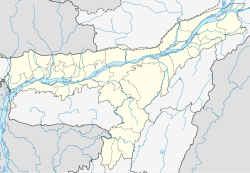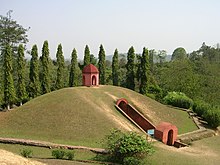Historical city in Assam, India
| Charaideo Che-Rai-Doi | |
|---|---|
| Historical city | |
 Mausoleum of Ahom royals buried in Charaideo Mausoleum of Ahom royals buried in Charaideo | |
  | |
| Coordinates: 26°56′31″N 94°52′34″E / 26.94194°N 94.87611°E / 26.94194; 94.87611 | |
| Country | |
| State | Assam |
| District | Charaideo |
| Languages | |
| • Official | Assamese |
| Time zone | UTC+5:30 (IST) |
| ISO 3166 code | IN-AS |
| Vehicle registration | AS |
Charaideo or Che-Rai-Doi (Literally: the shining city on the hills in Ahom language) is a historic town situated in Charaideo district, Assam, India. Charaideo was established by the first Ahom king Chao Lung Siu-Ka-Pha in the year 1253 CE as the first capital of the Ahom kingdom. Even though the capital was shifted to different cities over the course of 600 years of Ahom rule, Charaideo remained the symbolic centre of Ahom power in Assam. It is now famous for its vast collection of maidams (tumuli) which are the burial mounds of the ruling Ahom kings and members of the Ahom royalty.
It is located about 30 km from Sivasagar town in Charaideo district.


Etymology
Charaideo (also Ahom: Che-Rai-Doi; Charai-khorong), was the permanent settlement of the first Ahom king Chaolung Sukaphaa. It was earlier referred to as Che-Tam-Doi-Phi (literally City-Hill-God) meaning "city of the sacred hill". The name Charaideo originated from Tai-Ahom word Che Rai Doi or Doi Che Rai which means the shining city on the hills. The word Che-Rai-Doi became Charaideo or Charai-khorong in Assamese. According to the Tai-Bailung-Mohong Buranji (a manuscript in Tai), King Sukaphaa was buried in his capital city Che-Rai-Doi.
History

Before the arrival of Sukaphaa the place was a place of worship for local tribes like Moran, Borahi. Though the capital of the Ahom kingdom moved many times, Charaideo remained the symbolic center. It contains sacred burial grounds of Ahom kings and queens and is also the place of ancestral Gods of the Ahoms. The Ahom kings and Queens were buried after extensive and long royal burial rituals. The tombs (Maidam) of Ahom kings and queens at Charaideo hillocks resemble the shape of the pyramids and are objects of wonder revealing the excellent architecture and skill of the sculptors and masons of Assam of the medieval days.
The actual number of Maidam were more than 150 but only 30 Maidams are protected by the Archaeological Survey of India and Assam State Archaeology Department, and the remaining Maidams are unprotected. Most of these unprotected Maidams are encroached by people and getting damaged. The biggest unprotected Maidam is the Bali Maidam near Nimonagarh. This Maidam is called Bali Maidam, because while British plundered it, they got obstruction from excess sand (bali) in the surrounding of the Maidam.

Nomination for UNESCO World Heritage Site

In 2023 Prime Minister Narendra Modi chose the Maidams for a UNESCO nomination as a World Heritage Site. The site was formally recognised as such on 26 July 2024.

See also
Notes
- built his first capital on a permanent basis on a small hill the high fcot-hill area adjacent to that of Lang-Ku-Ri Deo. ... Tai Che-Rai-Doi, Assamised into Charaideo or Charai-khorong and Sans- kritized into Bihagachal… Gogoi, Padmeswar (1968). The Tai and the Tai kingdoms: with a fuller treatment of the Tai-Ahom kingdom in the Brahmaputra Valley. Dept. of Publication, Gauhati University. pp. 264 & 265.
- built his first capital on a permanent basis on a small hill including the high fcot-hill area adjacent to that of Lang-Ku-Ri Deo. ... Tai Che-Rai-Doi, Assamised into Charaideo or Charai-khorong and Sans- kritized into Bihagachal… Gogoi, Padmeswar (1968). The Tai and the Tai kingdoms: with a fuller treatment of the Tai-Ahom kingdom in the Brahmaputra Valley. Dept. of Publication, Gauhati University. pp. 264 & 265.
- (Phukan 1992, p. 53)
- Gogoi, Padmeswar (1968). The Tai and the Tai kingdoms: with a fuller treatment of the Tai-Ahom kingdom in the Brahmaputra Valley. Dept. of Publication, Gauhati University. pp. 264 & 265.
- Bezbaruah, Ranju; Banerjee, Dipankar; Research, Indian Council of Historical (2008). North-East India: interpreting the sources of its history. Indian Council of Historical Research. p. 117. ISBN 9788173052958.
- Gohain, Birendra Kr (1999). Origin of the Tai and Chao Lung Hsukapha: A Historical Perspective. Omsons Publications. pp. 72 & 73.
- Pan-Asiatic Linguistics: Proceedings of the Fourth International Symposium on Languages and Linguistics, January 8-10, 1996. Institute of Language and Culture for Rural Development. 1996. p. 1023.
- Texts and Contexts in Southeast Asia: Proceedings of the Texts and Contexts in Southeast Asia Conference, 12-14 December 2001. Universities Historical Research Centre. 2003. pp. 73 & 74.
- Centre, UNESCO World Heritage. "Moidams – the Mound-Burial system of the Ahom Dynasty". UNESCO World Heritage Centre.
- Moidams – the Mound-Burial system of the Ahom Dynasty, Archaeological Survey of India Guwahati Circle
- "Charaideo Maidams". www.assaminfo.com.
- gogoi, Pushpadhar 1998, An evaluation of original Tai Culture Heritage ... (PDF), sealang.net
{{citation}}: CS1 maint: numeric names: authors list (link) - Hazarika, Nagen 2004, Ahom language: It's typology language contact ... (PDF), sealang.net
{{citation}}: CS1 maint: numeric names: authors list (link) - "Pyramid-like Ahom burial mounds in Assam to vie for UNESCO World Heritage Site tag". The Hindu. 21 January 2023. Retrieved 22 January 2023.
- "India's moidam royal burial mounds are its latest World Heritage Site". Associated Press. 26 July 2024.
References
- Phukan, J. N. (1992). "The Tai-Ahom Power in Assam". In Barpujari, H. K. (ed.). The Comprehensive History of Assam. Vol. 2. Guwahati: Assam Publication Board. pp. 49–60.
- Capitals of Ahom kingdom
- Archaeological sites in Assam
- Former populated places in India
- Former capital cities in India
- Cities and towns in Charaideo district
- Charaideo district
- 1228 establishments in Asia
- 13th-century establishments in India
- Buildings and structures completed in the 13th century
- Ahom kingdom
- Tourism in Assam